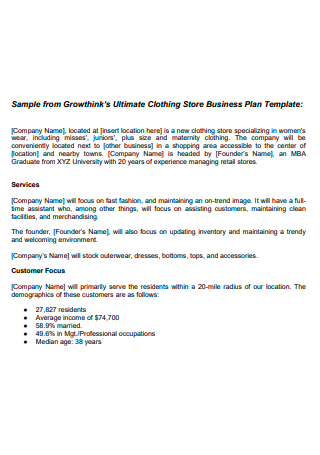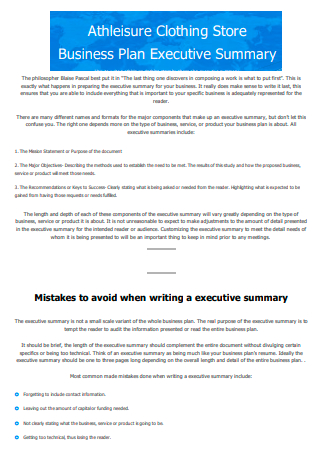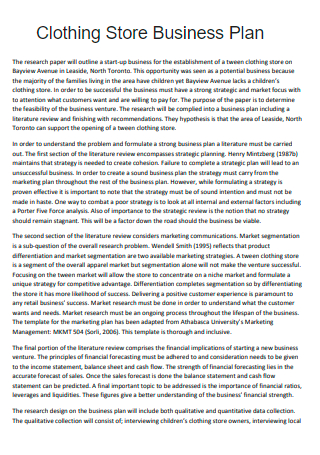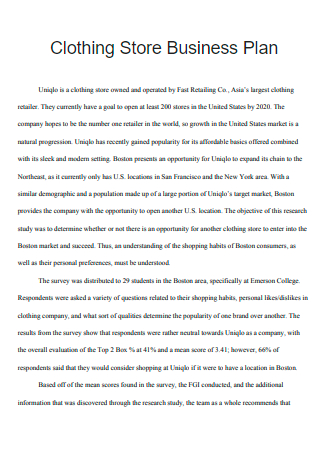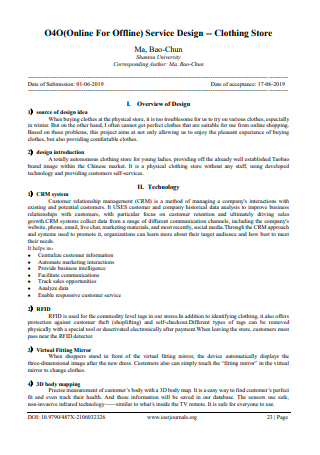5+ Sample Clothing Store Business Plan
FREE Clothing Store Business Plan s to Download
5+ Sample Clothing Store Business Plan
What Is a Clothing Store Business Plan?
Things to Prepare before Starting a Clothing Store
Two Sides of Having a Clothing Store
How to Start a Clothing Store Business Plan
FAQs
How profitable is a clothing business?
How to start an online clothing business?
What is the difference between a boutique and a clothing store?
What Is a Clothing Store Business Plan?
The business description for a clothing store is a business that sells ready-to-wear clothing. A business plan is a written document that details how a company, usually a startup, defines and aims to attain its goals. A business plan lays out a written course for the organization from a marketing, financial, and operational standpoint. It is more advantageous to prepare a business plan before jumping right into the business so that you can think of the relevant points before spending not only your allocated budget but also your time. Be sure to check out the clothing store business plan examples in this article.
Things to Prepare before Starting a Clothing Store
The fashion industry will never go out of style; nonetheless, there are a few things you will need to know before opening a clothes boutique. People of all ages, sizes, and style preferences will always need clothes, therefore flexibility in determining your target market is also inherent in retail apparel. You might find rich chances as a clothes store owner if you have a strong history in retail sales and a passion for fashion. Furthermore, knowing these details could help you as you write your business plan.
Two Sides of Having a Clothing Store
It takes a lot of effort to run a clothing store, but that goes for any business. In general, the retail model is a pain, as it necessitates purchasing merchandise in advance and handing it over at a profit. Clothing has high-profit margins, making it a popular and profitable company for many entrepreneurs. Clothing stores come in a wide variety of styles, from boutique to resale, and each has its own set of benefits and drawbacks. Give this list a read to find out what you can gain and potentially lose from owning a clothing store.
How to Start a Clothing Store Business Plan
Reaching this point in the article means you are ready to begin writing a business plan for your clothing store. Remember that it is a crucial process to plan for the details of how your clothing store will operate. So to have an easier means of managing your ideas, make use of this article’s provided templates. Not only will you save time in filling in the contents but you also won’t have to worry about the layout. Additionally, you can pay attention to the example of a clothing store business plan prepared which you can use as a reference.
Step 1: Executive Summary
The executive summary is the first and most important aspect of a business plan’s success. This section will summarize your business plan and highlight the main points you will cover in the rest of the document. This section of your business plan is critical since it is here that you must grab the reader’s attention and persuade them to keep reading.
Step 2: Business Analysis
The nature of your retail business is described in this area. It should include information about your company’s structure, legal name, location, and the products or services it provides. It also includes a review of your clients and rivals. When writing this section, don’t strive to be innovative. Use language that is simple to understand and understandable to the general public. You should never assume that the people reviewing your business plan have the same degree of technical expertise as you.
Step 3: Marketing Strategy
The marketing strategy portion of your retail business plan should detail how you plan to reach out to your target market. This section contains information about the company’s desired image and branding strategy. If applicable, you should include a summary of the company’s pricing tactics, current, and potential marketing collaborations, and support your approach with documented research. Otherwise, if your clothing store has no existing details on those, you can project what you intend for your marketing strategy.
Step 4: Products and Services
This section of the business strategy is critical for shops that are just starting. The products and services section outlines the goods and services offered, how they are delivered, vendor information, and any intentions for future product line expansion. You can also specify who will be manufacturing the clothes you will be selling in your store.
Step 5: Management Plan
The information in the management section should demonstrate that your retail company has the essential human resources to succeed. This section addresses concerns about your key management individuals and their histories discusses how the store will be staffed and covers all salary and benefits, as well as employment policies and procedures. As mentioned in the list found above, you will need a qualified crew to run your clothing store.
Step 6: Financial Plan
The financial plan is one of the more complex sections of the business plan as it deals with the company’s revenue and profitability model. This section of your business plan evaluates the amount of capital required by your retail firm. It also discusses the funds’ intended usage as well as their predicted gains in the future. Break-even analysis, sales forecasts, balance sheets, and cash flow statements are all included in the financial method. Make sure to break down the finances monthly for the first year, then annually for the next two to five years.
FAQs
How profitable is a clothing business?
Profit margins for retail clothing are typically between four and thirteen percent. When these costs are factored in, the clothing company’s profit is significantly reduced, and clothing stores must sell a huge amount of products to stay in business. Feel free to view business plan examples for a clothing store that is readily provided in this article.
How to start an online clothing business?
The most significant advantage of selling online is the decreased entry barriers. Setting up an internet store can take a few days or weeks, however, getting started in a more traditional setting can take considerably longer. The typical cost of opening a clothes store is $50,000 to $150,000, but most online clothing company models cost far less. You can check out online clothing store business plan examples.
What is the difference between a boutique and a clothing store?
The two terms are commonly interchangeable and would require extra observation to distinguish them from each other. The small variety of goods sold is a strong indicator that a store is a boutique. Boutiques are specialty stores that sell a restricted number of items. Clothing, makeup, hair products, and sometimes even food may all be available in one location at a huge retail chain.
The end indicates you have thoroughly researched and read all there is to know about writing a business plan for a clothing store. It may not be easy to start one but if you continue to pursue your dream of opening it, one day it will happen with your determination. Having a solid plan is better than not having any ideas to put into reality. And so, with this clothing boutique business plan template, you are well-equipped to start the planning process.

